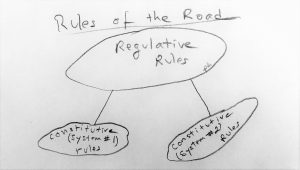Dynamical systems are composed of parts that participate in organized behavior that persists through many internal time cycles. The coherence of action of a set of parts that otherwise might have no relation to one another is how we recognize the system and are able to describe and talk about it. The condition of being organized represents a restriction on the behavior of a system and its parts, and can be described by a set of rules reflecting the necessities of being organized.
Such rules are meta-rules that apply to every dynamical system. They are called here regulative rules because they appear to regulate behavior. The rules are implicit in the definition of a system via the requirements of organization and persistence. They provide broad constraints on what parts and system must do if their behavior is to be consistent with observed coherent behavior of a set of parts. By describing what happens, but not the reasons why, the rules are essentially (to borrow a term from physics) kinematic rather than dynamic. In physics, kinematics refers to the motion of particles in the absence of a force (cause), whereas dynamics provides an explanation of how particles move when forces are present. Regulative rules don’t offer specific reasons that a given system and its parts behave as they do, but only that certain behaviors are required for consistency with observed system coherence.

Reliance on non-specific meta-rules may seem like a weak basis on which to analyze technosphere behavior, but it gains traction for several reasons. Regulative rules don’t distinguish one system from another, they provide a convenient way of thinking about the relation of a system to its parts independent of system identity. The rules provide insight into the behavior of essentially every system comprising the technosphere, including cows, cars and computers, as well as the technosphere itself.
As a corollary of particular importance in the Anthropocene, regulative rules of the system apply equally to humans and to buttons (and other technological artifacts) in their roles as components of the technosphere, notwithstanding the difference between human intentionality and consciousness and the evidently simple mechanical properties of a button.
Because regulative rules are independent of technology, they remain applicable whatever new (and unanticipated) technologies may appear, and so again provide a useful tool for system analysis in the Anthropocene, a time of rapid technological change. In their kinematic nature, regulative rules cannot predict dynamical transitions. However, if major technological transformations occur, for example if AI networks should cohere into a major component of the technosphere, the same set of regulative rules would apply to the transformed technosphere as well as to all its subsystems.
In addition to rules stemming from the fact of being organized, systems are also subject to regulative rules arising from basic physics. These include relations such as the conservation laws (e.g., of momentum, angular momentum, energy and mass) as well as the second law of thermodynamics. As “laws” of physics, these rules are regulative because they apply to all systems regardless of system identity. The restrictions that they impose, like those of the rules of organization, act to constrain system behavior. For present purposes, energy conservation and the second law of thermodynamics turn out to be the most useful regulative relations deriving directly from physics. These rules and some of their consequences will be treated in chapter 5, The Technosphere and Its Parts.
In addition to conforming to a set of generic regulative principles, a given system is also governed by specific constitutive relations, i.e., rules that depend on its constitution—how the system is actually realized. Constitutive rules are often dynamical, explaining how or why a certain system works in the way it does. For example the behavior of a radio and its parts is understood largely on the basis of constitutive rules of electrical engineering, i.e., through concepts such as Ohm’s law–the relation between voltage and current in a circuit. Different constitutive rules apply to different kinds of systems. For example, constitutive rules on the production and consumption of goods, such as a “law” of supply and demand, are invoked to help explain how economic systems work.
To investigate most questions regarding a specific system it is necessary to move to a constitutive level of analysis. I do this in later chapters when examining the human condition in the Anthropocene. At the same time, regulative rules of behavior are always in action behind the scenes. They apply to all systems, from mobile phones to humans, universities, corporations, governments, and military alliances on up to the global technosphere. As such they provide a useful framework for discussing the constitutive question of what it means to be human (or a human) in the Anthropocene. In the next post I examine the first of several regulative rules that will play important roles in this essay.
Further reading
The distinction between regulative and constitutive principles goes back at least to Immanuel Kant [1790], “Critique of Judgment”. See “Kant’s Critique of Judgement”, translated and with introduction by J. H. Bernard, 1914; http://oll.libertyfund.org/titles/kant-the-critique-of-judgement.
Persistent citation for this post: P. K. Haff, 3.3 Regulative and constitutive rules, in Being Human in the Anthropocene blog, 2018. https://perma.cc/KQL7-TQ4D.
Next up: 3.4 The Rule of Performance. A basic regulative rule for parts: that, with provisos, each part must act to support the metabolism of its host system.
